How to form Benjamin's ficus with your own hands - instructions for beginner florists
Ficus Benjamin belongs to the category of popular indoor plants. The main advantage of decorative culture is considered to be ease of maintenance and spectacular appearance.
It is very important to water the flower in a timely manner and systematically prune the shoots.
Below you can find out how to form Benjamin's ficus, with the peculiarities of crown formation and the rules for pruning.
Why shape Benjamin's ficus
Ficus needs a systematic formation. The systematic carrying out of formative pruning of ficus makes it possible:
- Create an effective design. Thanks to the unusual shape of the crown, decorative culture can become a highlight of the interior. The pruning procedure should be taken creatively. It is important to think over the desired outlines of the ficus in advance and take into account the peculiarities of the growth of its branches.
- Rejuvenate the culture. By pruning old shoots, you can stimulate the active growth of young branches.
- Sanitize. In the process of forming the ficus, it will be necessary to remove old shoots that have dried up, branches with yellowed and twisted foliage.
Important! Ornamental culture after pruning has the opportunity to improve its health and begin to develop faster. A tropical evergreen tree will become a real home decoration.
Timing
To form the crown and activate the growth of the ficus, it is recommended to carry out the pruning procedure in mid-March. In the autumn period, the formation of the plant is not carried out, since the culture must gain strength in order to survive the cold season.
If you cut the branches in winter, then the growth of young shoots will be observed exclusively in the place of the cuts. The crown will look one-sided. During pruning, it is important to get rid of damaged and dried shoots without regret.
Basic formation rules
The procedure for forming a houseplant is carried out in mid-March. Below you can find the basic rules of the process.
- Do not prune and transplant at the same time. For ornamental culture, these activities will become too much stress, therefore, at least 14 days must elapse between the process of crown formation and transplantation.
- Before proceeding with pruning, you should disinfect the instruments. For this purpose, you can use alcohol.
- The main trunk should be trimmed once a year. Do not cut more than 30 cm in length.
- Shoots should be cut above the bud. Young branches should be cut horizontally, and adults should be cut obliquely.
- After the formation procedure, it is necessary to apply fertilizer to the soil.
- When pruning, it should be borne in mind that at least 5 leaf plates should remain on the branch.
- The cut area is treated with a small amount of coal.
- It is not recommended to prune diseased and weakened plants.
- With the formation of stumps, the appearance of the ficus deteriorates. Bacteria begin to accumulate in this area. That is why you should not allow them to form.
- The aerial root system should not be cut off; it will be enough to direct it into the soil.
- To achieve the splendor of the ficus, it is worth cutting off the upper buds from the branches. Thus, it is possible to achieve a slowdown in upward growth and an increase in volume.
How to prune properly
Before proceeding with the formation of the crown, you need to stock up on the following inventory:
- pruning shears with sharp blades;
- small scissors, with which you can conveniently trim thin small shoots;
- activated carbon;
- alcohol.
Note! To prevent viruses from entering the cut area, you should treat the blades of the instrument with a solution that contains alcohol.
How to properly trim the crown for beautiful growth
Excess shoots can be cut off at any time, but full pruning should be done only in March. To perform the procedure, it is recommended to use a pre-disinfected equipment, which will make it possible to avoid damage to the bark and prevent infection.
The slices are made obliquely over the dormant buds. The cut area is treated with a small amount of crushed activated carbon.
Curly trim
To give the plant an original appearance, you can form a crown by giving it a curly shape. Most often, flower growers prefer spherical outlines. To this end, you will need to pinch young specimens from above. In adult bushes, the central shoots are cut off.
Lateral young branches should be cut in stages. It is best to start at the end of winter. You can give the desired shape to the crown until mid-summer. Shoots appearing in the lower part of the trunk should be removed.
If desired, you can form a two-level stem. For this, the crown of the ficus is divided into several parts. The first and third will be located in the upper area. The second part should be placed between the levels. In this case, it is recommended to free this area from all shoots.
When forming 3 levels, it is necessary to divide the crown into 5 parts. The first, third and fifth will serve as the upper future levels, which have a spherical shape. If it is supposed to form 3 levels, then the crown must be divided into five parts.
Note! When forming a ficus from top to bottom, it is worth removing the upper part of the stem and cutting it off.
Forming a ficus Benjamin using weaving a trunk
Ficus Benjamin can be shaped by braiding the stem.
Table 1. The most popular methods of plant formation.
| The form | Description |
| Spiral |
The spiral is considered the most common form of weaving. Even the presence of two sprouts and three weaves allows you to achieve maximum decorativeness. The length of young plants should be identical (not more than 20 cm). At the same time, the stem part should be lignified by 50%. Most often, flower growers install a strong support near the trunk of a perennial. Around her, the plant begins to weave stems. It is important to systematically cut the lateral branches. Once the coil has reached the desired size, the support is removed from the barrel. |
| Pigtail |
To give the stem part an unusual shape, it is worth planting several ficus seedlings in one container, the length of which does not exceed 13 cm. Side branches are removed from the stems. The soil in the pot is abundantly moistened, which makes it possible to achieve maximum flexibility of the stems. 12 hours after watering, you can start braiding. The growth of the stem does not differ in intensity. That is why braiding will take many months. The braided stem is tied with soft woolen threads. With weak weaving, gaps will form between the trunks. In the case of too thick weaving, drops of milky juice may appear. Don't worry. The wounds will heal quickly enough. The ligation of the stem is carried out at an angle of 45 degrees. |
| Column | If desired, you can achieve the effect of accretion of trunks into one large one. For this purpose, the bark is carefully removed from the seedlings in the joint zone. There should be no lateral branches on the stem. The joints should be secured with soft threads. It will take about 6 months to wait for the trunks to grow together.It is important to change the threads every 4 weeks to prevent them from growing into the bark. |
| Lattice |
To create such forms of ficus, it is advisable to purchase 8 seedlings, which will need to be planted on the same line with a small distance from each other (3-4 cm). It is important that this distance is the same. The length and width of all shoots are identical. The stem should not be lignified. Soon the growth of the seedlings will be intense. As soon as the height of the plants reaches 13 cm, you should start forming the green grid. For this purpose, you will need to take a cardboard tube. By inserting it into the central part, you can cross the trunks standing nearby. The wire in the winding can be used to guide them to the desired position. The retainers are systematically loosened to prevent damage to the bark and shoots. |
| Chokkan |
Tekkan is ideal for creating bonsai. The straight stem is rather wide, free from branches in the lower region. The root system is branched. Closer to the upper area of the crown, the number of branches decreases. |
| Moyogi |
The stem of the plant is curved in several places. This effect can be achieved by wrapping the barrel with wire and giving the culture the desired shape. The tree is upright. The crown is compact. It rarely leaves the container. |
| Shakan (oblique) |
The stem of the ficus is tilted to one side. The root system turns out from the opposite side. The trunk of the culture is wrapped in wire. The plant should be gently tilted to one side. A weight is tied to the tip of the top, which will help direct the growth of the flower in one direction. |
| Sokan (forked) |
This type of bonsai gives the impression that a couple of trees grow from one root system. The first plant is considered the parent. The second is a child. The perennial parent looks tall and stout. The child is rather short and slender. |
| Hokidachi (broom) | This form of bonsai is quite difficult to create. It is very important to achieve divergence of branches and root system in opposite directions from the trunk by creating a suitable wire frame. |
| Yose-ue (grove) | To create a similar bonsai shape, you will need to plant several ficuses in one container, which will differ in age category and trunk thickness. Compositions made up of 5 perennials look amazing. |
How to make bonsai
Bonsai is considered a miniature tree, the appearance of which repeats the outlines of large relatives. As a blank, it is worth using varieties of ficus like Natasha and Exotics. The listed varieties have a number of advantages, namely the presence of:
- branched root system;
- the original trunk - ornate, curved or grooved;
- amazing bark (textured and colorful);
- small foliage;
- intensive growth.
When creating a bonsai, you should not use ordinary varieties, since this process will take at least 7 years, but using the varieties of ficus listed above will help grow bonsai in a couple of years.
When creating a bonsai crown, you will need to systematically cut not only the stems, but also the leaf plates. Trimmed foliage looks unkempt and brown. Pruning is done regularly during the spring and summer months.
To form the stem part, it is worth using an ordinary wire with insulation. It is important to avoid wrapping the barrel too tightly with wire to avoid scarring. The wire is wrapped around the stem and around the branches. After 5-7 weeks, the perennial will be able to independently maintain the proposed outlines. From this point on, the wire can be cut.
Shaping with guides
When forming a perennial culture, it is important not only to shorten the lateral branches, but also to direct the shoots in the desired direction.For this purpose, it is worth using special tensioning devices or rigid wire. In the case when 3-4 shoots are directed in the wrong direction, do not cut them off. It is best to take a piece of wire, twist it around the main stem and the necessary shoot, which with careful movements bends in the desired direction.
To change the direction of the shoots, it is worth using the spacers between the branches. A layer of foam rubber is placed under the ends of the spacers, which will make it possible not to harm the bark. To achieve a large distance between the shoot and the stem, pull the branch down and fix it in a similar position with a weight.
After 14 days, all devices should be removed from the ficus. From this moment on, the growth of the shoots will be carried out in the right direction. A longer presence of the wire on the plant will cause it to grow into the culture.
How to form a ficus crown by grafting
Grafting is the process of transplanting one culture to another. Such manipulations are most often used in a situation where the ficus was formed incorrectly, as well as in cases of defective crown development.
There are situations when in some areas of the ficus there is not enough branch. To correct this situation, a florist can use grafting, which helps to speed up the process of ficus formation. After a short period of time, there will be no trace left on the plant in the place where the grafting was made. A young shoot will begin to grow in the empty area by this time.
Note! The use of the grafting method allows you to form a plant, as well as combine 2-4 varieties of ornamental crops of the same family.
Step by step process
- The pinching tool is disinfected.
- The area of the upper shoot is trimmed below the bud. Experts recommend using a straight cut.
- After finding the leaf plates that are located below the area of the selected height, the shoot located slightly higher is trimmed (oblique cut). The bottom of the cut will be at the level of the kidney on the other side. The top level will be above the kidney.
- The milky juice is removed from the plant with a damp napkin. After 30 days, it is worth adding top dressing to the soil.
Tips from experienced florists
Below you can find tips from florists who are growing ficus benjamin.
- Before the pruning procedure, the soil in flower pots is abundantly moistened. Sheet plates are cleaned of dust and dirt deposits.
- Small shoots are cut straight. Only thick branches can be cut obliquely.
- It is important to treat each area of the cut as soon as possible with a small amount of activated corner.
- In order to achieve the most effective appearance of the plant, it is important to cut off the branches that thicken the plant in a timely manner.
An exquisite plant, with proper care, can become a real decoration of a room. Using the trunk weaving procedure, you can create a unique composition that will surely attract the attention of guests. The tips of florists suggested above will make it possible to avoid the most common mistakes that a beginner often makes.
Video instruction for the procedure:



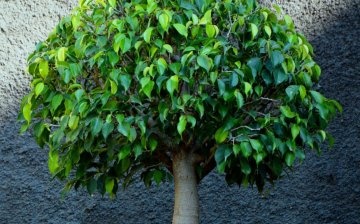

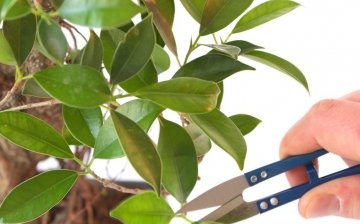



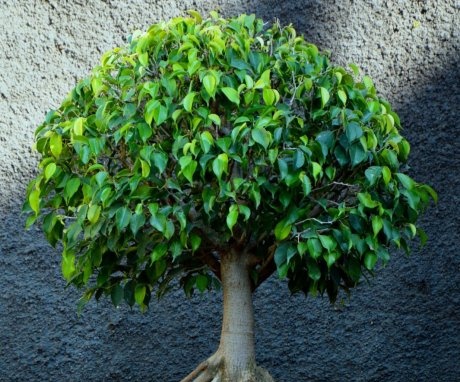
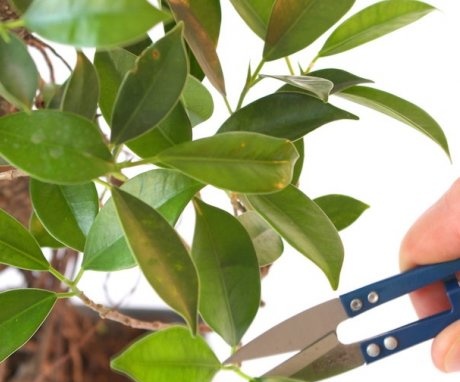
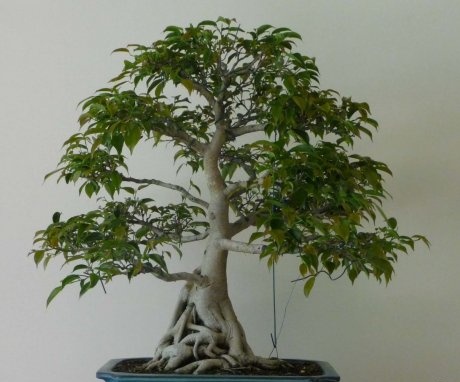
We have Benjamin's ficus growing for several years, we have never pruned him. Ficus grew into a beautiful tree, about a meter high. He had a beautiful crown, an even trunk. This, of course, is not a bonsai, but, in itself, a very beautiful plant.
Please share your experience, how and with what did you feed the tree and how did you fertilize the earth? Are there any other features? I really want to grow such beauty at home)